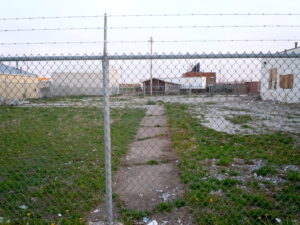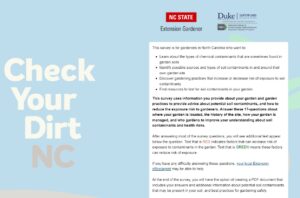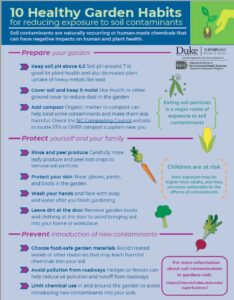Sample Case Study: Soil Contamination
go.ncsu.edu/readext?858041
en Español / em Português
El inglés es el idioma de control de esta página. En la medida en que haya algún conflicto entre la traducción al inglés y la traducción, el inglés prevalece.
Al hacer clic en el enlace de traducción se activa un servicio de traducción gratuito para convertir la página al español. Al igual que con cualquier traducción por Internet, la conversión no es sensible al contexto y puede que no traduzca el texto en su significado original. NC State Extension no garantiza la exactitud del texto traducido. Por favor, tenga en cuenta que algunas aplicaciones y/o servicios pueden no funcionar como se espera cuando se traducen.
Português
Inglês é o idioma de controle desta página. Na medida que haja algum conflito entre o texto original em Inglês e a tradução, o Inglês prevalece.
Ao clicar no link de tradução, um serviço gratuito de tradução será ativado para converter a página para o Português. Como em qualquer tradução pela internet, a conversão não é sensivel ao contexto e pode não ocorrer a tradução para o significado orginal. O serviço de Extensão da Carolina do Norte (NC State Extension) não garante a exatidão do texto traduzido. Por favor, observe que algumas funções ou serviços podem não funcionar como esperado após a tradução.
English
English is the controlling language of this page. To the extent there is any conflict between the English text and the translation, English controls.
Clicking on the translation link activates a free translation service to convert the page to Spanish. As with any Internet translation, the conversion is not context-sensitive and may not translate the text to its original meaning. NC State Extension does not guarantee the accuracy of the translated text. Please note that some applications and/or services may not function as expected when translated.
Collapse ▲Written by Chiara Klein, Duke Superfund Community Engagement Core
On the outskirts of a small town, there is a dirt lot surrounded by chain link fencing. The lot has been vacant for almost five years now and the town has never moved to build on it. In the past, the town was home to many industries, and many of the old factory buildings remain. A group of local residents have been considering turning it into a community garden, pending approval from the town council. The local residents have never started a garden before. They are thinking about costs, what to grow, and how to manage the site, but before they break ground there are other things to consider.

smallbones CC0
Gardening and eating homegrown produce are healthy and rewarding activities, But it’s important to be aware of the previous land uses at your garden site and potential health risks from chemical contaminants in the soil.
Chemical contaminants – such as heavy metals and organic compounds like PCBs or petroleum products – can enter into garden soil and ultimately our bodies if we are not careful. We can be exposed by breathing in dust from contaminated soil, by absorbing contaminants tracked inside on shoes, or by eating unwashed produce.
This might sound scary, but there are a lot of easy actions you can take to keep yourself and others safe. The Duke University Superfund Research Center’s Community Engagement Core, in partnership with NC State Extension Gardener, has developed several resources to help gardeners understand which chemical soil contaminants may be present in their gardens, as well as how to test their soil for contaminants, how to avoid introducing further contamination into their gardens, and how to limit exposure to contaminants in the garden.
To return to our local residents attempting to construct their community garden, the first thing they might want to do is work through our survey “Check Your Dirt NC.” This survey is designed to help gardeners understand what their specific risk of contamination might be, and how to limit exposure. The survey asks how the land was used before becoming a garden – this provides a great opportunity for gardeners to learn about the land-use history on their plot. In our example, the fact that it was a former industrial site means that future gardeners should try to find out exactly what stood on their plot before they begin gardening on it. There are many ways of learning about past land use – a simple Google search can be a great place to start!
Once they have a better sense of the former land use, they will have a better idea of which, if any contaminants might be present on the land. This will help them decide whether they need to test their soil for chemical contaminants, and, what to test for. More information on soil testing can be found on the Soils page of the NC State Extension Gardener site, and in the “How can I learn more about my garden site?” video within the Gardening Safely video series.
If soil testing is necessary, once results have been obtained, it is helpful to learn more about the contaminants present in the soil and the associated health risks they may pose. The Chemical Contaminants in the Soil page contains eight fact sheets on common contaminants that can be viewed online, downloaded, and printed.
Armed with knowledge, the community gardeners can now begin to build and implement the elements of their garden that will help limit their exposure. These include building raised garden beds, planting ornamentals, planting hedges to prevent airborne contamination from roadways, adding compost, and choosing the right garden materials. The Check Your Dirt NC survey has information about many of these options.
Once the garden is up and running, there are still more ways to protect those working in the garden. These include washing produce, not bringing garden gear (gloves, boots, etc.) into the house, and washing your hands. These tips can be found on the “10 Healthy Garden Tips” factsheet and in the Gardening Safely video series.
All of these resources are available to gardeners, and anyone who wants to learn more about gardening safely. For more information or to inquire about additional learning opportunities, please contact CEC Program Coordinator Chiara Klein at chiara.klein@duke.edu.
Resources Mentioned:




